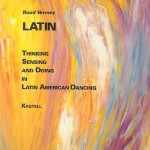… suggest e-motion
By Ruud Vermeij
One of the pitfalls/problems in Latin American Competitive dancing is the tendency to emphasise the “narrative” element of a couple dancing together. The “male part” tends to become increasingly macho, exceedingly heterosexual. This image is created by the overt gestures in the choreography, the exaggerated facial expression, and the exaggerated costumes and by the accompanying clichéd commercial music. The “woman’s” part is exaggerated in the same way presenting an unsubtle image of a stereotypical sexy female.
All to often dancers are taught to be more sexy, feminine, butch, macho, masculine, even words as “high class prostitutes” have been used to explain the characterization. I believe that those words are insulting to the dancer as a human being and even suggest that if we are ourselves we are not a man or a woman enough. As a dog may walk on his hind legs, but he cannot lose his “dogginess” so a dancer who is a human being can never lose his “humanness”.
Because a dancer is a person he or she can never be wholly abstract. A male person is a man dancing, a female person is a woman dancing. Together the statement is made. Nothing more is necessary to create man and woman, one does not have to “act” man or woman.
The notion of abstraction can be particularly useful in relation to this problem for the choreographer, and the dancers themselves. They have a joint responsibility. “To abstract is to draw out the essence of the matter. To abstract in art is to separate certain fundamentals from the irrelevant material which surrounds them” (1)
We can draw out the essence of a moment in a dance by attending to one or two of the movement structures. We are already man or woman so we can diminish the “acting out” of our “maleness” of “femaleness” and concentrate on the fundamental structure which gives that particular moment its “life” in the dance.
To do this it is essential to understand how the flexible torso movements, the zig-zag parading floor patterns and the alternating impulse/impact rhythms of the Samba are its very essence. They are the fundamentals of the dance and need to be created by the dancer. They do not exist outside of the moving dancer’s body. When the dancer changes the emphasis from torso to hips spending time sinking into transferences of weight, sliding past and circling around their partner, merging impact/impulse rhythms to create a continuity of movement we no longer see the Samba but these movements collectively create the Rumba. Devotion to the motion will more economically, more clearly, more accurately, more excitingly, more subtly create the essence of the dance.
Martin confirms this about western ballroom dancing “…that in dances of this character the curved line is predominant in design. Sometimes this is for the sake of emphasising the natural curves of the body and sometimes it is to keep the eye of the onlooker constantly returning to the body.” (2)
So abstraction in Latin American dancing might be a commitment to twisting actions, changes of weight, staying on the spot, and qualities of weightiness. To add irrelevant extras reinforces stereotypical and behavioural gestures that have nothing to do with the dances. The painter Wassily Kandinsky neatly reinforces the necessity to keep the unnecessy out of art:
“I could never employ forms bij proceeding from logical processes, only those born within me by an inner necessity. The form of a horse becomes more magical the further I depart from an actual horse.” (3)
In Latin it has to do with the degree of abstraction from the subject matter, the male/female relationship. When the emphasis is too much on telling a “story”, there is nothing left for the imagination of the spectator. Over-abstracting might create a feeling of being too far removed from the dancers and the dance giving a cooler impression with the emphasis on design, form, or space.
A male/female relationship in Latin Dance should sustain the illusion and leave something to the spectators imagination. It contains a semblance of reality that we can identify but not so clearly presented that we can only put it into words.
Choreographers who are dance teachers and have the most influence on the dancers performance need to understand abstraction as an aspect of the creative act.
When an idea is to represent a cape, one first has to learn to lift the abstracted qualities, the lines shapes and rhythms from the source of motivation. Secondly the abstracted qualities need to be removed from their every day setting. In the Paso-Doble the “cape” is not in the bull-fight arena and is not a “real” cape. It is symbolized through the female dancer, who remains female and is not in the arena. She creates the illusion of a cape. Thirdly the choreographer has to organize those lines, shapes, and rhythms into a form that holds the original concept in an abstracted way. When not abstracted and the woman tries to “represent” the cape as literally as possible, it can become comical rather than illusionary. Although this example is obvious the same applies in more subtle representations like the flirting behaviour of the male/female, and the creation of the characterization of each dance.
The dance should sustain an illusion, and not endeavour to represent the idea literally. The illusion contains and is created by the abstracted elements manifest through the shape and form of a moving human being and therefore embodies feeling which is symbolic.
Ruud Vermeij
From his book Latin Thinking and Sensing











